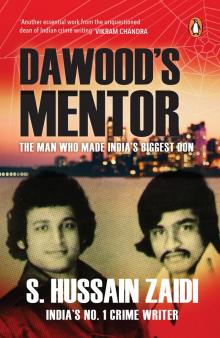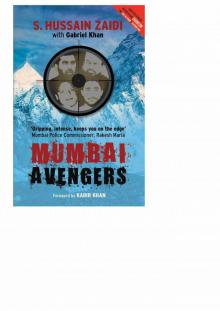- Home
- S. Hussain Zaidi
My Name is Abu Salem Page 3
My Name is Abu Salem Read online
Page 3
By 1989, Salem had become one of Anis’s top lieutenants in Mumbai. The smuggling business also proved to be lucrative, and his boss was happy. People had begun to know of Salem and some had also begun to fear his name and his growing clout. Salem was beginning to enjoy the power and the dread that he evoked. By now, he had invited several of his struggling cousins from his village to join him in Mumbai and become his henchmen. Soon, Salem was being hailed as a hero of sorts in Azamgarh. The villagers began mentioning his name with deference. From Salem, he was now called Salem Bhai.
Two
Salem and Sameera
SALEM WAS A WOMANIZER AND A Casanova. He craved female company and could not be without a woman for long. His friends often referred to him as a sexual predator.
Soon after his arrival in Mumbai, he learnt the ways of the city and the finer nuances of chasing girls. Already known to be a charmer, he further honed those skills when he realized that girls were drawn to sweet-talking men. Salem had learnt from the movies that Mumbai’s girls are rather stylish and attractive. Ultimately, he wanted to be married to a Mumbai girl so beautiful that she could even pass off for a silver screen heroine. He had seen plenty of movies and knew that a self-respecting hero must have a girlfriend. In his mind, he was as good-looking as any Bollywood hero, so why shouldn’t he have an attractive girlfriend?
Barely twenty then, Salem found it difficult to focus on his work and was often distracted. His cousin Akhtar and other relatives scolded him and urged him to get some direction in life, but Salem did not give up his quest for a girl. After he finished his work at Arasa Shopping Centre, he would often go to Juhu beach and ogle at the women there.
Finally, his relatives convinced his mother Jannatunissa to summon him to the village and get him married as he was at risk of going astray in the big bad city. When Salem reached his village, the news of his impending marriage came like a bombshell. There was no way he wanted to get married so early in life, but his elders prevailed upon him and he had to give in.
Salem was wedded to a girl from the village of Khudakpur, six kilometres from his own village of Sarai Mir. The nuptial ceremony was a small affair and only a few guests had been invited. Salem reluctantly brought his new bride to Mumbai and returned to his routine. The marriage was doomed from the start—since the couple was inherently incompatible, and fought frequently—and did not last long. After consulting his elders, Salem took his wife back to his village and sought a divorce. In later years, he would refuse to acknowledge that he had ever married anyone from his village. However, Abu Kalam claimed that Salem was briefly married before he started chasing girls in Mumbai.
Salem had rented a new flat in D.N. Nagar, Andheri, and he happened to notice a young girl living just across his flat. Her name was Sameera Jumani and she was studying in the junior-level science stream of Bhavan’s College, Andheri. Salem was immediately smitten by Sameera’s drop-dead good looks and began following her to college every day. Soon, Sameera too, like many other gullible young girls, was drawn to his sharp features and began to fall for him. There was an age gap of five years between the two, but Sameera would not let that dissuade her. She believed that Salem was her man.
Salem would go to her college astride a motorcycle and woo her. Later, when he had a car, he regularly drove around Andheri with the good-looking young woman by his side. ‘Salem was aware of Sameera’s young age and her devoted love for him. As a gesture of love, Salem would sometimes sing a song from the hit Bollywood film Ek Duje Ke Liye, starring Kamal Haasan and Rati Agnihotri. “Solah baras ki baali umar ko salaam, aye pyaar teri pehli nazar ko salaam” (Salutations to the tender age of sixteen and salutations to the first glance I ever had of you, my love), he would croon,’ recalls one of Salem’s close associates.
Her father was a businessman and as soon as he realized that his daughter was interested in Salem, he put his foot down. Sameera belonged to a conservative Ismaili Khoja family and she was forbidden from marrying outside her jamat. Salem, too, was a devout Muslim who refused to join the Ismaili faith which was what her family would have required of him.
Sameera’s parents were also completely opposed to her having this relationship while she was still in college and they tried to reason with Salem’s relatives, but he was beyond reason. They then tried to persuade Sameera to stop seeing Salem, but she was madly in love. She refused to even look at the economic inequality between her family and Salem.
In the two years of their courtship, Salem had grown from a mere shopkeeper in Andheri to a budding smuggler, while Sameera had managed to finish her junior college and gained admission to an undergraduate programme. Then one day, Sameera’s parents decided that enough was enough and planned to get her engaged to a suitor from the Ismaili community. Salem then decided to elope with her.
In the meantime, Kalam, the only one amongst the inner circle who knew Salem since he was a child, repeatedly tried to convince him that Sameera was a young girl and he shouldn’t ruin her life—not to mention the fact that they belonged to different sects. But Salem had made up his mind and they got married after a courtship of two years, on 4 January 1991. At the time, Sameera was seventeen years old and a minor according to Indian law.
The Jumani family lodged an FIR against Salem at the D.N. Nagar police station and he was charged with abduction. But Sameera threatened suicide and it was only after Salem’s family intervened that the Jumanis relented and withdrew the case. Salem was freed and they both relocated to a new house.
Within a few months of their marriage, Sameera learnt of Salem’s illegal activities and his underworld liaisons. She was shocked. But there was no going back. She was already married to Salem and he was deeply entrenched in his business. He could neither have been expected to abandon his business which had just begun to give him the comfortable life he so craved for, nor could Sameera have left him as she was far too comfortable in his company.
But March 1993, which changed many destinies in Mumbai, including that of Salem’s, was not far away.
Three
The First Brush
ABU KALAM, SALEM’S CHILDHOOD FRIEND AND cousin, had never seen the inside of a cell. Yet there he was, stripped down to his underwear, his hands tied to the wall and a car tyre around his waist. Aside from his anguished screams, the only thing he could hear was the resounding thwack of the thick police-issue belts as they were whipped across his back.
Through eyes that had long glazed over with pain, he could see four burly policemen taking turns at thrashing him, oblivious to his screams and pleas for mercy. After they’d had enough of beating him with sticks, they began kicking him in the kneecaps, the back, his buttocks and shoulders. One policeman took particular pleasure in slapping him across the face. Kalam, like Salem, was slightly vain. He believed he was extremely good-looking and this reflected in his style of dressing. It did not take the policeman very long to realize this, so he dedicated himself to slapping Kalam’s face till it was swollen or until a tooth chipped. This torture continued for a whole day.
On the second day, Kalam was convinced that the pain would be a little easier to handle, but these policemen were veterans. The longer Kalam continued to stonewall on Salem’s location, the worse the thrashings got. But he did not allow the pain to overcome his loyalty and, confident that Salem would send someone to bail him out, Kalam kept quiet. It was at the end of the second day of beatings that Kalam began to get angry at Salem. Every time he was slapped, whipped, kicked or punched, the policemen would ask, ‘Salem kidhar hai?’ And every time Kalam would reply, ‘Nahin maloom, saheb.’ His loyalty to Salem was unwavering.
Now, after two days of continuous beatings and very little food, water or sleep, Kalam was on the verge of total breakdown. On the third day, he came to the conclusion that Salem had probably made full use of the forty-eight hours that Kalam had bought him, to lie low at some safe location. There was absolutely no reason to protect him any more. Kalam was furious at Salem, and at himself. He b
egan thinking back on the events of the day which had landed him in jail.
One fateful evening, Salem had announced to Kalam that they were going to meet a businessman in Bandra and that he would be handing over a few lakh rupees. There was no explanation provided and none was required by Kalam. Perhaps Salem had some business with the businessman, thought Kalam to himself, and that this was a payment. They set off on a motorcycle and rode to Turner Road. After arriving at the location, Salem began to look around suspiciously. He told his trusty sidekick to dismount and go and meet the man. Salem would join them shortly. Not suspecting a thing, Kalam hopped off the bike and strolled over into the businessman’s office.
‘Salem and his friend are here,’ he announced, ‘tell your boss!’
Kalam was taken into the man’s office and he swaggered in as if he owned the place. He sat down and cockily said that Salem had sent him to collect the money. The businessman nodded, stood up slowly and walked out of his office. Kalam waited, leaning back into the soft cushion of the office chair, expecting the man to return with a bag of money. Would it be in a black briefcase, he wondered. Before he could know the answer to this question, he was being slapped in the face and dragged by two hefty men in plain clothes to a jeep waiting below the building. Kalam had walked right into a trap.
Salem had probably suspected something fishy and that’s why had decided to let Kalam get nabbed rather than risk his own capture. ‘He must be around, I don’t know,’ was Kalam’s response to the police when he was nabbed. He wasn’t lying—he truly had no clue. The cops brought him to Bandra police station and over the last few days had tried their best to get him to speak.
After three days of beatings, Kalam’s face was swollen, his teeth were broken, his eyes were black, and his body was covered with welts and bruises. Enough was enough, he decided. If a policeman were to lay as much as a hand on him again, he would send them straight to Salem’s doorstep. Soon, a policeman walked over. Kalam braced for impact.
To his surprise, the khaki-clad man began to untie the ropes that bound his ankles and wrists. He was then made to put his clothes back on. Something had clearly happened, he figured, as he stumbled gingerly. It was only when he saw the lawyer and Salem’s friend Riyaz Siddiqui sitting with the police that the penny dropped. After three days of twiddling his thumbs, Salem had finally come through. Kalam was released and Siddiqui led him out to a taxi. The journey was silent. Kalam wanted to save all his words for Salem, and Siddiqui wasn’t in too chatty a mood either.
When they arrived at Salem’s place, he looked totally remorseless. In his naïveté, Kalam had expected more from Salem. A lot more. The least he could’ve done, thought Kalam, was hug him for his loyalty and refusal to snitch on Salem. A bit of concern or sympathy about his injuries would have been appreciated too. And while Kalam wasn’t looking for any material reward, he would have gratefully accepted one. But Salem was totally indifferent to the last three days of trauma his long-time friend had faced.
That’s when Kalam lost his control. He attacked Salem with a barrage of expletives demanding to know why he didn’t come to his rescue. After all, they were friends, they had come to Mumbai together and now they were in business together.
Finally, Salem broke his silence. He said calmly, ‘Arre, Kalam bhai, yeh toh dhanda hi aisa hain. Don’t take these things so seriously. They happen all the time.’
Kalam simply could not understand how Salem could be so callous and be unmoved by his plight. But he also realized that there was nothing he could do. Salem wouldn’t change. The priority was always his own safety and well-being. Nothing and no one else mattered.
But Salem soon felt the tentacles closing in around his own neck in the hands of one of the most ferocious officers of the Mumbai Police. In the late eighties and early nineties, Mumbai was going through a watershed moment when the mafia was trying to establish itself. Gang wars between Dawood Ibrahim and Arun Gawli, a millworker-turned-ganglord and ex-crony of Dawood, were starting to take their toll on the city. In the meantime, Khalistani terrorists were moving from Punjab to Mumbai (into predominantly Sikh areas such as Bhandup, Mulund and Sion). The Sikhs there used to store weapons, give refuge to militants on the run and plot terrorist attacks. Mumbai’s streets ran red with blood.
It was to tackle this situation that the Mumbai Police instituted its anti-terrorist squad (ATS). This was led by an officer called Aftab Ahmed Khan, seen on the silver screen in the 2007 film Shootout at Lokhandwala. The ATS office was in Bandra, but its jurisdiction was all of Mumbai city. This is especially astounding when you realize that it was a unit of just twenty-two men handling an entire city’s rising graph of violence. While Khan was involved in several violent skirmishes with Khalistani terrorists in Bhandup and Mulund, he was also keeping a keen eye on the increasing clout of the underworld in the suburbs.
He had heard about Aziz, Chauhan and Salem, who were operating between Mahim and Andheri. He sent them a message, inviting them to meet with him. Aziz and Chauhan promptly did so and assured him that they would steer clear of all illegal activity. Salem did not feel the need to meet this policeman. This irritated Khan. How could this hoodlum have the audacity not to turn up when summoned? Khan wanted to teach the upstart a lesson.
Khan was returning to his headquarters one day, in a bad mood after a faulty tip-off, when he and his men happened to spot Salem outside the Arasa Shopping Centre with some of his cohorts. Salem was the perfect target to vent his frustration on. Khan ordered his men to pick Salem up right there and then. The policemen rushed out of their vehicle and set upon him with hockey sticks. The ATS in those days was bereft of any smart weapons, so they had to make do with such unorthodox options. They grabbed Salem and beat the living daylights out of him at the gate of the shopping centre. This would be Salem’s first introduction to the ways of the Mumbai Police.
Following the brutal beating, Khan wanted to make an example out of Salem, and instructed his men to tie him by the wrists to the back of the jeep, so that he appeared to be almost crucified across the back of the vehicle. And then, with this novel car ‘ornament’, Khan told his men to drive to the nearby D.N. Nagar police station. People watched, as a bruised and battered Salem was taken to the police station where he was promptly handed over to the officers in charge.
He was then detained for two days and given a thick slice of the Mumbai Police’s own brand of special treatment. While Salem was behind bars and on the receiving end of brutal thrashings, his friend Topi was ambushed and killed by Inspector Emmanuel Amolik near the Yellowgate police station. Suddenly, the position of Anis Ibrahim’s top man in Mumbai had opened up.
Somehow, Salem’s friends were able to put together Rs 25,000 (a huge amount in 1991) and arranged to have him released on bail. He quietly walked out of the police station with Aziz and Chauhan, who led him into a car. As he returned to the Arasa Shopping Centre to be reunited with his cousin Akhtar, Salem was surprised at the welcome he received. The garlands and applause made it seem like some sort of a hero had returned home from war. Aside from being seen as a hero, the other benefit of putting up with the police’s brutality was that Anis had taken notice. He was now talking directly to Salem, who had leapfrogged over Aziz and Chauhan.
As for the ATS, after the 1993 riots, Khan reportedly became too big for his boots and a law unto himself, leading to the squad being unceremoniously disbanded.
Four
Salem and Sanjay
STANDING ON ONE LEG, THE OTHER knee bent in a sort of bastardized version of the vrikshasana, Sanjay Dutt looks positively Godzilla-esque in the promotional material and posters of the film. He stands between the comparatively smaller images of co-stars Madhuri Dixit and Jackie Shroff, the film’s title emblazoned below—Khalnayak, The Villain.
His clothes are an eyesore—a semi-chequerboard, semi-striped suit ensemble, complete with a white polka-dotted black tie and matching hat. He is tipping his hat jauntily, with a black-gloved hand. But the most
bone-chilling part of the look is the demented grin on Sanjay’s face—the expression in his eyes screams out pure, unadulterated, evil insanity.
As he says in the movie, ‘Jee haan, main hoon khalnayak!’
Ghai released his film on 6 August 1993, four months after Sanjay was arrested under the stringent Terrorist and Disruptive Activities (Prevention) Act, or TADA. It was a rather unremarkable film that might have tanked completely had it not been for director Subhash Ghai’s masterstroke in releasing it when lead actor Sanjay Dutt was in jail. It raked bountiful returns at the box office. To cinemagoers, film and real life had fused. Sanjay was truly the embodiment of his memorable proclamation—a khalnayak.
Born to superstar parents, actors Sunil and Nargis Dutt, on 29 July 1959, Sanjay was always given the very best that life had to offer. The youngest of three siblings (after sisters Priya and Namrata), Sanjay received most of his education at Lawrence School, Sanawar, in Himachal Pradesh. He is believed to have been troubled as a youth and later fell upon difficult times, turning to habitual substance abuse during his teens.
Expectations for Sanjay to join Bollywood were especially high after both his sisters decided not to enter the world of cinema. While Sanjay made his official Bollywood debut in the 1981 tale of vengeance, Rocky, his first appearance on the silver screen was actually as a junior actor with a cameo in the 1971 film Reshma Aur Shera. Gradually, more film offers began rolling in and through the 1980s, Sanjay began to establish himself as a reliable action hero. With his chiselled physique and regal mane, cinemagoers began to realize that it wasn’t his surname alone that was bringing him success.

 Dawood's Mentor
Dawood's Mentor HEADLEY AND I
HEADLEY AND I Mafia Queens of Mumbai
Mafia Queens of Mumbai Byculla to Bangkok
Byculla to Bangkok Black Friday
Black Friday The Endgame
The Endgame My Name is Abu Salem
My Name is Abu Salem Mumbai Avengers
Mumbai Avengers Dongri to Dubai - Six Decades of the Mumbai Mafia
Dongri to Dubai - Six Decades of the Mumbai Mafia Eleventh Hour
Eleventh Hour